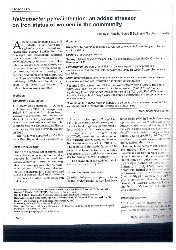Please use this identifier to cite or link to this item:
http://hdl.handle.net/11054/144Full metadata record
| DC Field | Value | Language |
|---|---|---|
| dc.contributor.author | Peach, Hedley G. | en |
| dc.contributor.author | Pearce, Dora C. | en |
| dc.contributor.author | Farish, Stephen J. | en |
| dc.date.accessioned | 2013-01-09T03:29:45Z | en |
| dc.date.available | 2013-01-09T03:29:45Z | en |
| dc.date.issued | 1997 | en |
| dc.identifier.govdoc | 00128 | en |
| dc.identifier.issn | 0025-729X | en |
| dc.identifier.uri | http://hdl.handle.net/11054/144 | en |
| dc.description.abstract | Objective: To investigate the prevalence of Helicobacter pylori infection and potential risk factors for infection in an adult Australian population. Design: Cross-sectional study. Setting: Ballarat, a major regional city in Victoria (population, 78 000; 92% born in Australia), November 1994 to July 1995. Participants: 217 adults randomly selected from the electoral roll. Main outcome measures: H. pylori IgG antibody status by enzyme immunoassay; amount of dental plaque; sociodemographic and other potential risk factors; odds ratios for risk factors determined by logistic regression analysis. Results: Age-standardised prevalence of H. pylori infection was 30.6%. After adjustment for age, sex and socioeconomic index, positive H. pylori status was significantly associated with increasing number of tooth surfaces with a high plaque score (odds ratio [OR], 1.7; 95% confidence interval [CI], 1.1-2.7), increasing number of years in a job with public contact (OR, 1.7; 95% CI, 1.3-2.3), blood group B antigen (OR, 3.1; 95% CI, 1.1-9.1), and having lived in a household with more than six members during childhood (OR, 2.5; 95% CI, 1.1-5.5). Negative H. pylori status was significantly associated with increasing education, having ever lived on a farm, and having teeth scaled less than once a year. Conclusions: H. pylori infection is common. Dental plaque may be a reservoir for H. pylori, which is probably transmitted by person-to-person contact, and blood group B antigen may predispose to infection. Community education about effective oral hygiene and adoption of good hygiene practices by those with regular public contact may be important to prevent acquisition and transmission of H. pylori . | en |
| dc.description.provenance | Submitted by Gemma Siemensma (gemmas@bhs.org.au) on 2013-01-09T03:29:33ZNo. of bitstreams: 0 | en |
| dc.description.provenance | Approved for entry into archive by Gemma Siemensma (gemmas@bhs.org.au) on 2013-01-09T03:29:45Z (GMT) No. of bitstreams: 0 | en |
| dc.description.provenance | Made available in DSpace on 2013-01-09T03:29:45Z (GMT). No. of bitstreams: 0 Previous issue date: 1997 | en |
| dc.publisher | Australasian Medical Publishing Company | en |
| dc.relation.uri | https://www.mja.com.au/journal/1997/167/6/helicobacter-pylori-infection-australian-regional-city-prevalence-and-risk | en |
| dc.title | Helicobacter pylori infection in an Australian regional city: prevalence and risk factors. | en |
| dc.type | Journal Article | en |
| dc.type.specified | Article | en |
| dc.bibliographicCitation.title | Medical Journal of Australia | en |
| dc.bibliographicCitation.volume | 167 | en |
| dc.bibliographicCitation.issue | 6 | en |
| dc.bibliographicCitation.stpage | 310 | en |
| dc.bibliographicCitation.endpage | 313 | en |
| dc.publisher.place | Sydney | en |
| dc.subject.healththesaurus | HELICOBACTER PYLORI | en |
| dc.subject.healththesaurus | INFECTIONS | en |
| dc.subject.healththesaurus | REGIONAL | en |
| dc.date.issuedbrowse | 1997-01-01 | en |
| Appears in Collections: | Research Output | |
Files in This Item:
| File | Description | Size | Format | |
|---|---|---|---|---|
| MJA reproduced with permission. Peach, Bath and Farish.pdf | © Copyright 1998. The Medical Journal of Australia - reproduced with permission. | 1.38 MB | Adobe PDF |  View/Open |
Items in DSpace are protected by copyright, with all rights reserved, unless otherwise indicated.
